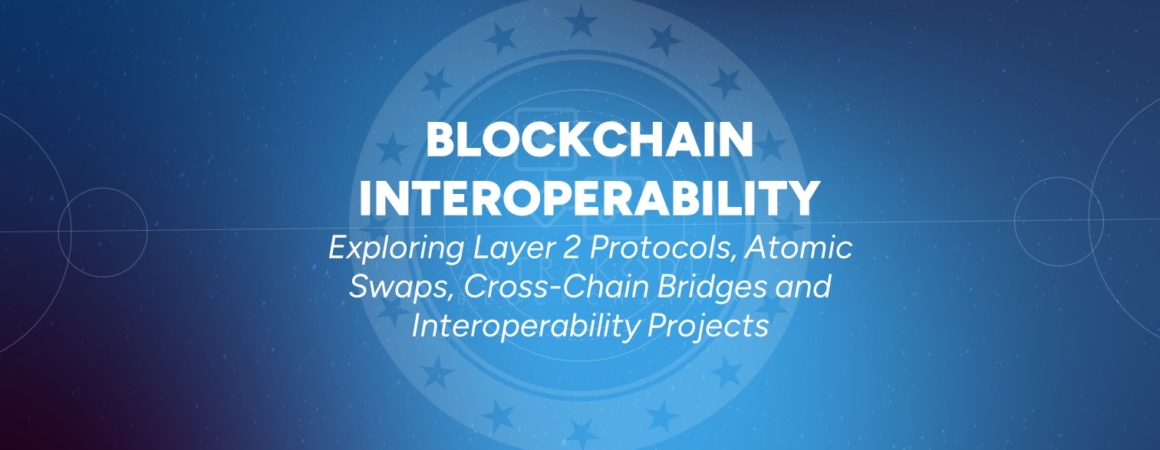
Regulatory Compliance in Enterprise Blockchain
Blockchain technology has emerged as a powerful tool for businesses, enabling secure and transparent transactions…

In the dynamic world of blockchain technology, the concept of blockchain interoperability stands as a pivotal force driving innovation and growth. But what exactly is blockchain interoperability, and why is it so essential?
Blockchain interoperability refers to the seamless communication between different blockchain networks, creating a unified and decentralized ecosystem. This shift is instrumental in facilitating asset transfers across diverse networks and establishing regulatory standards.
For a comprehensive understanding of the current state of interoperability between blockchain networks, you can refer to “The Current State of Interoperability Between Blockchain Networks” report by EU Blockchain Observatory and Forum. This report offers valuable insights into the progress and challenges surrounding blockchain interoperability in today’s rapidly evolving blockchain ecosystem.
First of all, to grasp the significance of blockchain interoperability, we must delve into its history, spanning three generations of blockchain technology. From the foundational days of Bitcoin and Litecoin to Ethereum’s introduction of smart contracts, the evolution of blockchain has been significant. The advanced interoperability offered by platforms like Tendermint Cosmos further illustrates how each generation has played a vital role in shaping the path to true blockchain connectivity.
Additionally, the blockchain interoperability market is on the rise, projected to reach USD 2.88 billion by 2032. This growth is driven by cross-chain transfers, expanding dApps, and a rise in decentralized finance (DeFi).
This article explores key elements in achieving blockchain interoperability, including Layer 2 Protocols, Atomic Swaps, Cross-Chain Bridges, and the Inter-Blockchain Communication (IBC) Protocol. Moreover, it also delves into notable projects such as Polkadot, Cosmos, Chainlink, Wanchain, Binance Bridge, Multichain Bridge, Thorchain, and Avalanche Bridge, highlighting how each project plays a crucial role in advancing scalability, security, and interconnectedness within the blockchain space.
Keep reading to dive deeper into each of the mentioned topics and gain a comprehensive understanding of blockchain interoperability.
“The ability of blockchain networks to communicate with each other, sending and receiving messages, data, and tokens” (Chainlink, 2023)
Blockchain interoperability refers to the ability of different blockchain networks to communicate and interact with each other without intermediaries. Furthermore, this concept is crucial for building a fully integrated and decentralized blockchain ecosystem.
As we move into 2024, there’s an evident shift towards creating an interconnected blockchain environment, emphasizing cross-chain compatibility to enable smooth asset transfers across various networks. Subsequently, this interoperability is crucial for the sustainable growth of blockchain technology and the establishment of regulatory parameters.
The history of blockchain interoperability can be seen through the evolution of blockchain technology across three generations. Each of them marked by significant advancements:
As of 2024, the Blockchain Interoperability Market is experiencing robust growth. Valued at USD 275.5 million in 2022, it’s projected to soar to approximately USD 2.88 billion by 2032, with a CAGR of 26.8%. This expansion is fueled by increasing demands for cross-chain asset transfers, advancements in decentralized applications (dApps), and the growth of decentralized finance (DeFi). The rise in global business transactions and the adoption of multi-blockchain applications also contribute significantly.
Blockchain interoperability is crucial for several reasons, as emphasized by various industry experts and sources:
Overall, blockchain interoperability is not just a technical necessity but a strategic imperative that drives the growth, innovation, and adoption of blockchain technology across various sectors.
Achieving blockchain interoperability is a multifaceted process, involving diverse cross-chain interoperability solutions, varied approaches, and specific protocols. In this article, we’re going to explore some of the main elements that constitute this complex landscape.
Within this framework, cross-chain interoperability solutions act as the practical tools enabling direct interaction between different blockchain networks. Blockchain interoperability approaches, on the other hand, serve as the strategic methodologies guiding the application of these tools. Meanwhile, blockchain interoperability protocols are the technical specifications and rules that ensure these interactions are secure, consistent, and efficient.
Each of these components plays a distinct yet complementary role, collectively contributing to the broader goal of creating interconnected blockchain networks.
These are specific tools or mechanisms designed to connect different blockchain networks. They facilitate direct asset transfers and communication between distinct blockchains, often utilizing additional layers or bridges.
These are broader strategies or methodologies adopted to achieve interoperability. These approaches outline the conceptual and strategic frameworks guiding how interoperability should be implemented or achieved.
These are sets of rules or standards that define how different blockchain networks can interact and integrate with each other. Protocols provide a standardized way for blockchains to communicate, ensuring that transactions and data transfers are secure, reliable, and consistent across different platforms.
Next, we’ll focus on some of the most pivotal and widely recognized solutions and protocols in blockchain interoperability, such as Layer 2 Protocols, Atomic Swaps, Cross-Chain Bridges, and the Inter-Blockchain Communication (IBC) protocol, each playing a vital role in advancing the connectivity and functionality of blockchain networks.
Layer 2 Protocols enhance the scalability and transaction speed of a primary blockchain by processing transactions on a secondary layer, which alleviates the load on the main chain. After these transactions are processed, their results are recorded back on the primary blockchain, thus boosting overall network performance.
Popular cryptocurrencies like Bitcoin and Ethereum use Layer 2 solutions. The Lightning Network is used for Bitcoin transactions, and Ethereum has various Layer 2 solutions like Arbitrum and Optimism.
Atomic Swaps allow for the exchange of cryptocurrencies between different blockchains directly, without intermediaries like exchanges. Utilizing smart contracts, these swaps ensure that either both parties fulfill their part of the deal or the transaction is automatically canceled. This is achieved through hash time-locked contracts (HTLCs).
A Hash Time Locked Contract (HTLC) is a smart contract used in blockchain transactions, which employs cryptographic hash functions and time-bound conditions to secure and automate the process of exchanging assets across different blockchains. This innovative contract ensures that transactions are completed only when pre-agreed conditions are met, enhancing security and trust in decentralized trading.
Atomic swaps are used by various decentralized exchange platforms and by users seeking direct peer-to-peer trading.
Cross-Chain Bridges are mechanisms that allow for the transfer of assets and information between different blockchains. They lock assets in a smart contract on one chain and issue equivalent assets on another chain. This enables interoperability between blockchains that wouldn’t normally communicate with each other.
Projects like Polkadot and Cosmos use cross-chain bridges for interoperability. Also, wrapped tokens like Wrapped Bitcoin (WBTC) on Ethereum are a form of cross-chain bridging.
The Inter-Blockchain Communication Protocol is a method for enabling secure, reliable interchain communication. It allows independent blockchains to exchange information and tokens with each other in a standardized way, maintaining the sovereignty of each chain.
It’s predominantly used in the Cosmos Network, allowing for interoperability between a wide range of blockchains within its ecosystem.
Blockchain interoperability has evolved rapidly, introducing transformative projects from multi-chain platforms to cross-chain bridges. Furthermore, these initiatives are key to advancing scalability and security, marking a new era in decentralized systems. Here’s a list of notable interoperability projects shaping the future of blockchain.
Polkadot stands as a revolutionary multi-chain platform, fostering unparalleled interoperability among diverse blockchains. In addition, it recently made headlines with its groundbreaking parachain auctions, which significantly enhance its scalability and efficiency. While challenges persist in ensuring seamless integration of different blockchains and maintaining network security, Polkadot’s approach offers substantial benefits in terms of scalability, governance, and innovation in decentralized applications (dApps). This makes it a promising solution in the evolving landscape of blockchain technology.
Cosmos, renowned for its “Internet of Blockchains” architecture, is a network designed to enable seamless cross-chain communication. Its latest development, the Stargate upgrade, introduces the Inter-Blockchain Communication (IBC) protocol, elevating its capability for asset transfers and data sharing. As a matter of fact, challenges include managing the complexity of interconnected blockchains while preserving security and sovereignty. However, Cosmos offers significant advantages in terms of scalability, usability, and an ever-growing ecosystem of interconnected chains, positioning it as a key player in blockchain interoperability.
Chainlink, a decentralized oracle network, bridges the gap between blockchain smart contracts and real-world data. In addition, it has recently expanded its services with off-chain computation capabilities to enhance smart contract functionalities. The primary challenge lies in ensuring data accuracy and preventing manipulation. However, Chainlink’s ability to securely and reliably bring external data onto the blockchain presents immense benefits for complex smart contracts, thus driving innovation and trust in decentralized finance (DeFi) and beyond.
Wanchain is a unique blockchain platform that emphasizes cross-chain compatibility and interoperability. Furthermore its recent integration with multiple leading blockchains marks a significant step in enhancing its interoperability capabilities. Despite challenges in achieving seamless cross-chain transactions and ensuring network security, Wanchain offers substantial benefits by connecting isolated blockchain networks, thereby enabling broader use cases and enhanced liquidity in the blockchain ecosystem.
The Binance Bridge serves as a pivotal bridge service, facilitating inter-blockchain liquidity between Binance Chain and Binance Smart Chain for decentralized applications. The recent expansion of its bridging capabilities to include more tokens and blockchains highlights its growing importance. Despite this, challenges revolve around maintaining security and efficiency in cross-chain transactions. On the other hand, the bridge significantly benefits users by offering greater flexibility, increased access to a variety of assets, and enhanced functionality across the Binance ecosystem.
The Multichain Bridge is an innovative cross-chain bridge dedicated to enhancing interoperability among disparate and previously isolated blockchains and dapps. It recently introduced new bridging mechanisms that increase transaction speed and reduce costs. The primary challenges include ensuring robust security measures and achieving wide-scale adoption. However, its ability to facilitate seamless asset transfers across various blockchains presents significant benefits in terms of enhanced connectivity and functionality within the blockchain space.
Thorchain is a cutting-edge decentralized cross-chain liquidity protocol that enables permissionless asset swaps. Moreover, its recent launch of synthetic assets and yield farming capabilities marks a significant enhancement in its offerings. Challenges include managing the inherent risks associated with decentralized finance and ensuring network stability. Nevertheless, Thorchain’s protocol provides substantial benefits by enabling efficient and decentralized trading across different blockchains, thus fostering a more integrated and versatile cryptocurrency market.
The Avalanche Bridge is a state-of-the-art solution offering a fast, secure, and cost-effective method for bridging assets between Avalanche and Ethereum. Recent upgrades improved speed and reduced costs, but challenges remain in maintaining high security and user-friendly interfaces. Yet, the Avalanche Bridge stands out with fast transactions and lower fees, appealing to users seeking efficient cross-chain interactions.
Interoperability emerges as a critical factor in the widespread adoption of blockchain technology. It’s the bridge that allows varied blockchain networks to collaborate effectively, therefore forging a more cohesive and potent ecosystem.
This synergy is essential in surmounting existing barriers like scalability challenges. Furthermore, seamless interaction among blockchains overcomes limitations and greatly expands their use in various sectors.
It’s this very interoperability that could propel blockchain from a niche innovation to a mainstream technology, integral in various industries. Interoperability fosters interconnected blockchain, unlocking its potential and paving the path for global acceptance and integration.
In conclusion, blockchain interoperability is the key element of the evolution of blockchain technology. It bridges the gap between diverse blockchain networks, forging a unified and robust ecosystem. Moreover, as we navigate 2024 and beyond, the landscape emphasizes cross-chain connectivity, vital for seamless asset transfers and regulatory standards. This article explores the history and market growth of blockchain interoperability. It highlights its key role in boosting efficiency, inclusivity, and innovation across sectors. The discussion covers key elements like Layer 2 Protocols, Atomic Swaps, Cross-Chain Bridges, and IBC, plus notable interoperability projects.
Embracing interoperability unleashes blockchain’s full potential, transcending limits and making it integral to various industries, propelling it into the mainstream. Consequently, the future of blockchain technology appears brighter than ever before.

Blockchain technology has emerged as a powerful tool for businesses, enabling secure and transparent transactions…

Welcome to the exciting world of blockchain! If you’ve ever wondered what this revolutionary technology…

Imagine if companies could share information and conduct business on a secure digital network where…